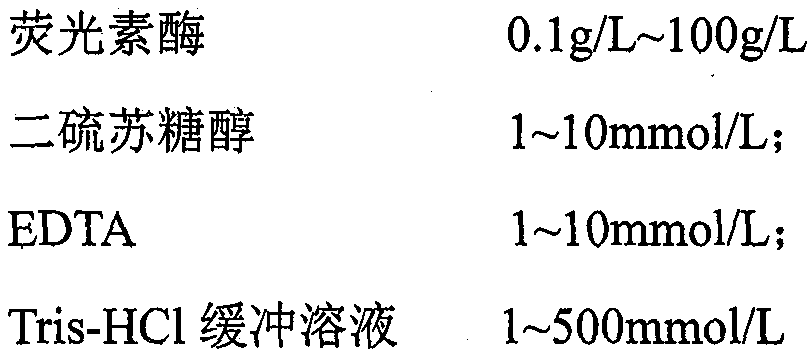A nanofiber membrane sensor with rapid detection of bacteria and its preparation method
A nanofiber membrane and sensor technology, applied in the field of nanofiber membrane sensor and its preparation, can solve the problems of one-time use of bioluciferase loss, increased use cost, weak interaction between luciferase luciferase and carrier, etc. To achieve the effect of preventing a large number of losses, saving costs, and simple design ideas
- Summary
- Abstract
- Description
- Claims
- Application Information
AI Technical Summary
Problems solved by technology
Method used
Image
Examples
preparation example Construction
[0032] The preparation method comprises the following steps;
[0033] Preparation of a biosensor for rapid detection of bacteria:
[0034] The preparation of A polyolefin copolymer nanofibrous film, described preparation adopts the preparation method that Chinese patent publication number is CN101553607A, is about to PVA-co-PE, cellulose acetate butyrate (CAB) according to mass ratio be 1: 4 mix homogeneously ,dry. Melting, blending and extruding through a twin-screw extruder, after collection, CAB is extracted by refluxing acetone at 60° C. for 72 hours to obtain nanofibers with a fiber diameter of ≤500 nm.
[0035] The nanofibers of PVA-co-PE extracted with acetone are dispersed in a certain solvent with a mass fraction of 1% to 5% to prepare a nanofiber suspension. Then, using high-pressure airflow forming technology, the nanofiber suspension is formed on various fiber fabrics.
[0036] Preparation of B active PVA-co-PE nanofibrous membrane
[0037] Place the PVA-co-PE ...
Embodiment 1
[0056]According to the above method, the prepared PVA-co-PE nanofiber membrane is placed in a container, mixed with a 2mol / L sodium hydroxide solution until completely soaked, and then the container is placed in a constant temperature water bath shaker at a constant temperature of 15°C , the time is 30 minutes, take it out, wash it, and dry it. Then mix the NaOH-treated nanofibrous membrane with a 1,4-dioxane solution with a mass fraction of 5% cyanuric chloride in a container until completely soaked, and place it in a constant temperature water bath shaker at a constant temperature of 15°C. , the time is 60 minutes, take out, wash and dry, and prepare a nanofiber membrane with active triazine on the surface.
[0057] Mix the above-mentioned active nanofiber membrane with 0.1g / L luciferase, 1mmol / L dithiothreitol, 1mmol / LEDTA, 1mmol / LTris-HCl buffer solution and stir evenly. The immersion temperature is 0°C. The time is 12 hours, and then washed with 1 mmol / L tris-HCl (pH=7.4...
Embodiment 2
[0059] According to the above method, the prepared PVA-co-PE nanofiber membrane is placed in a container, mixed with a concentration of 3mol / L sodium hydroxide solution until completely soaked, and then the container is placed in a constant temperature water bath shaker at a constant temperature of 25°C , the time is 20 minutes, take it out to clean and dry. Then mix the NaOH-treated nanofibrous membrane with a 1,4-dioxane solution with a mass fraction of 10% cyanuric chloride in a container until completely soaked, and place it in a constant temperature water bath shaker at a constant temperature of 20°C. , the time is 30 minutes, take out, wash and dry, and prepare a nanofiber membrane with active triazine on the surface.
[0060] Mix the above-mentioned active nanofiber membrane with 1g / L luciferase, 3mmol / L dithiothreitol, 3mmol / LEDTA, 50mmol / LTris-HCl buffer solution and stir evenly. The immersion temperature is 2°C, and the immersion time is for 18 hours, and then washe...
PUM
| Property | Measurement | Unit |
|---|---|---|
| diameter | aaaaa | aaaaa |
Abstract
Description
Claims
Application Information
 Login to View More
Login to View More - R&D
- Intellectual Property
- Life Sciences
- Materials
- Tech Scout
- Unparalleled Data Quality
- Higher Quality Content
- 60% Fewer Hallucinations
Browse by: Latest US Patents, China's latest patents, Technical Efficacy Thesaurus, Application Domain, Technology Topic, Popular Technical Reports.
© 2025 PatSnap. All rights reserved.Legal|Privacy policy|Modern Slavery Act Transparency Statement|Sitemap|About US| Contact US: help@patsnap.com

